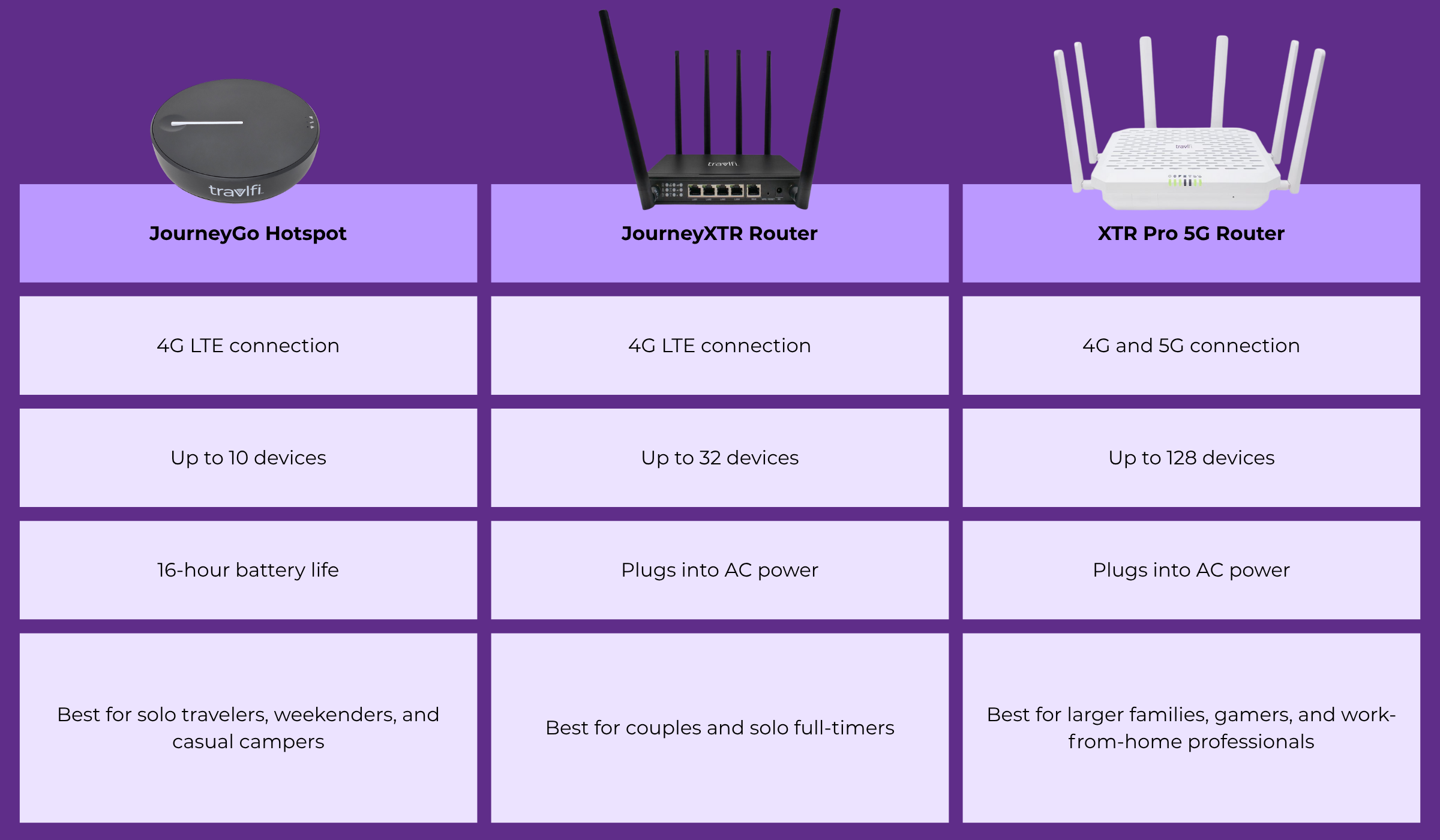
We’ve got the details on getting a seamless internet connection for camping, whether you’re in a campground or boondocking in the desert.
Staying connected to who and what you love while traveling the open road can be frustrating. We outlined 3 options for you to consider when choosing how to get internet in your RV.
Staying connected while on the road is no easy task.
The life of an avid RVer can (and will!) bring you to all kinds of places, some more forgiving than others. In general, lack of cellular coverage, data depletion, and simply not having an easy way to connect are all common challenges many RVers face, leaving them to sacrifice their ability to be connected to who and what they love when and wherever they want.
When considering the best way to stay connected while on the road, there are a few factors to consider:
- How often are you traveling?
- Are you traveling within or outside of the United States?
- What is it you are hoping to accomplish with your Wi-Fi?
- How many devices are you wanting to connect to?
Let's get started by reviewing the most common ways to get internet in an RV.
Traditional Wi-Fi Options for RVers
A few common options for getting internet in your RV are connecting to a shared Wi-Fi at an RV park, using a cellular device hotspot, or using a mobile hotspot, like the JourneyGo from TravlFi.
Mobile Hotspot
If you are hoping to get secure internet utilizing multiple networks with no contracts, quickly and affordably we recommend the TravlFi JourneyGo Hotspot. You’ll enjoy the simplicity of a small, mobile hotspot that is powered by pay-as-you-go data plans. Considering everyone has a different Wi-Fi demand, TravlFi offers a variety of secure plans that range from 2 GB all the way to 800 GB. Remaining connected to a single cellular network is not easy to accomplish when you are on the road, which is why TravlFi connects to all major data networks at no additional cost.
Learn the difference between a mobile hotspot versus RV WiFi router, and which one is best for your travels.
Campground Wi-Fi
Often, RV parks will offer free Wi-Fi to their campers and visitors. Unfortunately, while being connected through free public Wi-Fi may be appealing, there are a few downsides, like proximity to the Wi-Fi access point, the overload of guests at the park, and most importantly, security.
In today's world, cybercrime is becoming more and more popular (and advanced) and many public Wi-Fi options are not equipped to fight-off malicious activity. While the RV park offering the Wi-Fi connection has no intention of doing you dirty, the lack of Wi-Fi security could quickly land you (and your personal data) in troubled waters.
Learn more about whether or not public WiFi is safe.
Cellular Hotspot
Using your cellular hotspot is great for quick and meaningless tasks, as it is convenient, effortless, and probably works just fine for those one-off needs when you have service. When it comes to living in your RV full-time (or for a good portion of time), a reliable internet connection is a luxury that your trusty iPhone won’t always accomplish.
As an RVer, you are constantly moving from one place to the next and each location has its ups and downs when it comes to staying connected to your single cellular provider. SPOILER: Most 'unlimited' data plans will throttle data at certain caps or during busy times. Overall, relying on your cellular service for your internet needs is not the best long-term option, as it may not be reliable, and it could result in a hefty bill at the end of each month!
Compare unlimited RV internet plans: TravlFi vs. AT&T vs. T-Mobile vs. Verizon
Phone Hotspot vs. Mobile Hotspot
In the grand scheme of things, a cell phone hotspot and a dedicated mobile hotspot are both intended to achieve one thing: getting access to the internet. However, the way the two devices are used and designed is very different.
A cell phone hotspot is typically a feature found on your smartphone and uses the data provided by your network. A dedicated mobile hotspot is generally a separate device, like the TravlFi Journey1.
As an RVer, you want your device to get internet in your RV whenever you need it. The TravlFi Journey1 uses Embedded SIM (eSIM) technology, which brings you coverage where you need it most. Embedded SIM technology allows the device to change towers so it can find the strongest cellular signal in your area and automatically connects to that signal because TravlFi has access to all major networks (at no additional cost)!
So, unlike a cellular mobile hotspot, TravlFi allows you to benefit from more than one network, so you never have to be without high-speed internet access. Here are a few other things to consider when understanding why your cellular hotspot may not be the best long-term solution for the internet in your RV:
- While the hotspot feature on your phone is a convenient solution in a pinch, it is not the primary purpose of your smartphone so the speeds and signal strength will typically be less than a dedicated hotspot.
- Most cellular plans that include hotspot data limit you to 10–15GB, so the capability is limited for a primary source of internet.
- Lastly, using the hotspot on your phone will drain the battery quickly, leaving you with a dead phone.

Satellite Internet
Satellite internet has become a game-changer for RVers who venture beyond cell service zones. With satellite connectivity, your signal comes directly from orbiting satellites rather than nearby cell towers, which means you can get online in remote deserts, mountain passes, or national parks where traditional service drops off. Providers like Starlink have made satellite internet more accessible, offering faster speeds and lower latency than older systems.
However, satellite internet isn’t perfect. Equipment costs can be high, setup requires a clear view of the sky, and heavy data usage can quickly become expensive. Weather interference, especially heavy rain or snow, can also affect performance. For travelers who spend most of their time near populated areas, a reliable mobile hotspot or cellular-based plan may be a more affordable, plug-and-play option. But for those who love true off-grid exploration, satellite internet can fill the gaps no other service can reach.
TravlFi Takeaways
Getting internet in your RV can be tricky business, but it is nothing that can't be achieved. You know your RV lifestyle best, so find something that not only works for you, but is also secure, flexible, and most importantly, reliable.
FAQ
What do full-time RVers do for Wi-Fi?
Most full-time RVers rely on mobile hotspots, cellular data plans, or specialized RV internet devices to stay connected. Many use multiple options—such as TravlFi or similar hotspots, campground Wi-Fi, and cell boosters—to ensure coverage in remote areas. A mix of connections helps maintain reliable internet for work, streaming, and communication on the road.
What's the average cost of RV internet per month?
Monthly RV internet costs typically range from $50 to $200, depending on data limits, provider, and coverage needs. Budget users may get by with shared campground Wi-Fi or limited data plans, while remote workers often invest in premium mobile hotspots or satellite service for stronger, nationwide coverage. Adding a backup plan can increase total costs slightly.
What is the best portable wifi for RV?
The best portable Wi-Fi for RVs offers flexible data, wide network coverage, and reliable performance on the move. Dedicated mobile hotspot devices, such as those from TravlFi or other multi-carrier providers, are popular because they connect to major cellular networks and adjust coverage automatically. Look for devices that support multiple users and offer pay-as-you-go or contract-free plans.
How do people who live in RVs get WiFi?
People living full-time in RVs get Wi-Fi through several sources: mobile hotspots with cellular data plans, campground networks, satellite internet, or signal-boosting equipment. Most combine two or more methods to cover different travel conditions. For example, a hotspot or router provides internet on travel days, while campground or satellite connections help in remote locations.
More Essential Reading for RV Owners:
- Common Travel Mistakes for New RV-ers to Avoid
- How to Keep Your RV Cool During Summer
- How to Secure Your RV Wi-Fi in 2025: Expert VPN Tips
TravlFi Internet for Remote Workers and Travelers
TravlFi keeps you connected on the road. Not sure which device is best for you? Compare below.

Article By: Amanda Capritto
Amanda Capritto is a fitness and outdoors journalist who travels full-time in a Winnebago camper van. Her work has appeared in national and global outlets like Lonely Planet, Reader's Digest, CleverHiker, CNET, and more.

